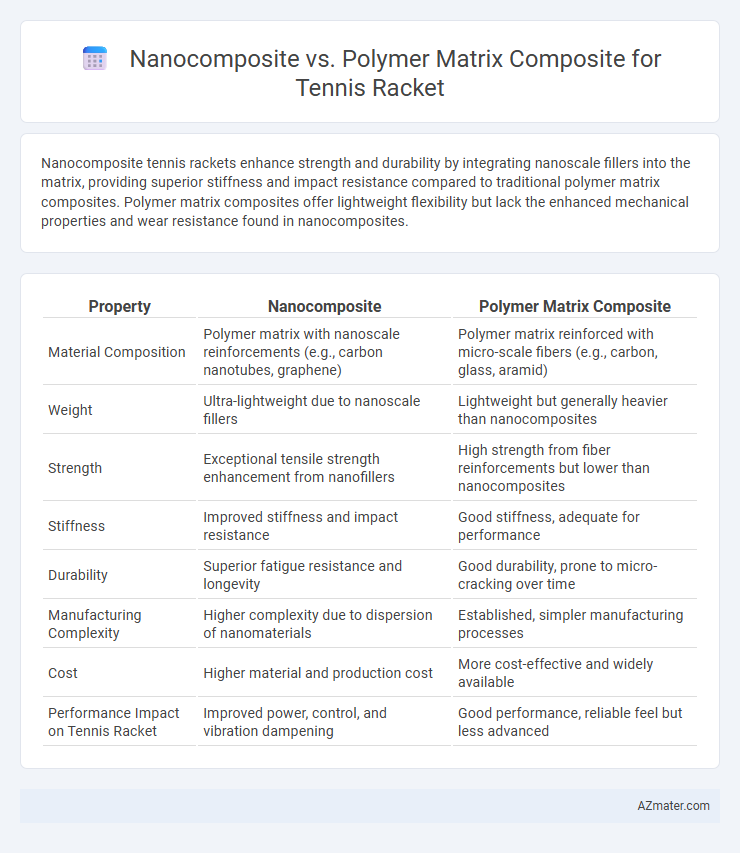Nanocomposite tennis rackets enhance strength and durability by integrating nanoscale fillers into the matrix, providing superior stiffness and impact resistance compared to traditional polymer matrix composites. Polymer matrix composites offer lightweight flexibility but lack the enhanced mechanical properties and wear resistance found in nanocomposites.
Table of Comparison
| Property | Nanocomposite | Polymer Matrix Composite |
|---|---|---|
| Material Composition | Polymer matrix with nanoscale reinforcements (e.g., carbon nanotubes, graphene) | Polymer matrix reinforced with micro-scale fibers (e.g., carbon, glass, aramid) |
| Weight | Ultra-lightweight due to nanoscale fillers | Lightweight but generally heavier than nanocomposites |
| Strength | Exceptional tensile strength enhancement from nanofillers | High strength from fiber reinforcements but lower than nanocomposites |
| Stiffness | Improved stiffness and impact resistance | Good stiffness, adequate for performance |
| Durability | Superior fatigue resistance and longevity | Good durability, prone to micro-cracking over time |
| Manufacturing Complexity | Higher complexity due to dispersion of nanomaterials | Established, simpler manufacturing processes |
| Cost | Higher material and production cost | More cost-effective and widely available |
| Performance Impact on Tennis Racket | Improved power, control, and vibration dampening | Good performance, reliable feel but less advanced |
Introduction to Tennis Racket Materials
Tennis racket materials have evolved significantly, with nanocomposites and polymer matrix composites being prominent choices. Nanocomposites integrate nanoparticles into polymer matrices, enhancing mechanical strength, impact resistance, and vibration dampening critical for racket performance. Polymer matrix composites, typically composed of carbon fibers embedded in epoxy resin, offer high stiffness-to-weight ratios and durability, making them a standard in professional tennis rackets.
Understanding Polymer Matrix Composites
Polymer matrix composites (PMCs) in tennis rackets consist of a polymer resin reinforced with fibers like carbon or glass, providing high strength-to-weight ratios and excellent flexibility for enhanced racket performance. Nanocomposites incorporate nanoscale fillers such as carbon nanotubes or graphene within the polymer matrix, significantly improving mechanical properties like stiffness, toughness, and impact resistance compared to traditional PMCs. Understanding the distinctions between nanoscale reinforcements and conventional fiber reinforcements is critical for optimizing the balance between durability, weight, and responsiveness in high-performance tennis rackets.
Exploring Nanocomposites in Sports Equipment
Nanocomposites in tennis rackets utilize nanoscale fillers like carbon nanotubes and graphene to significantly enhance strength, stiffness, and impact resistance compared to conventional polymer matrix composites, which rely on macroscale fibers such as fiberglass or carbon fiber. The incorporation of nanomaterials improves energy transfer and vibration damping, resulting in better control and power for players. Advanced nanocomposite structures also provide lightweight durability and superior fatigue resistance, making them increasingly popular in high-performance sports equipment design.
Key Differences: Nanocomposite vs Polymer Matrix Composite
Nanocomposites in tennis rackets incorporate nanoscale fillers such as carbon nanotubes or graphene within the polymer matrix, significantly enhancing mechanical strength, stiffness, and impact resistance compared to conventional polymer matrix composites (PMCs). Polymer matrix composites primarily use fiber reinforcements like carbon or fiberglass embedded in a polymer resin, offering good weight-to-strength ratios but generally lower performance improvements at the nanoscale. Key differences lie in the nanocomposites' superior interfacial bonding and energy absorption capabilities, resulting in lighter, more durable rackets with improved vibration dampening and playability characteristics.
Mechanical Properties Comparison
Nanocomposite tennis rackets exhibit superior mechanical properties compared to polymer matrix composites due to the integration of nanoscale fillers, which enhance stiffness, strength, and impact resistance. The high surface area of nanofillers significantly improves load transfer within the matrix, resulting in increased durability and reduced weight. These improvements contribute to better racket performance, offering enhanced control and power for players.
Weight and Durability Factors
Nanocomposites in tennis rackets offer significantly reduced weight due to the integration of nanoscale fillers like carbon nanotubes or graphene, enhancing stiffness without adding bulk. Polymer matrix composites, typically reinforced with fibers such as carbon or fiberglass, provide excellent durability but tend to be heavier than nanocomposites. The nanoscale reinforcement in nanocomposites improves fatigue resistance and impact strength, resulting in longer-lasting rackets optimized for both weight and durability.
Impact on Racket Performance
Nanocomposite materials in tennis rackets enhance impact resistance and stiffness by incorporating nanoparticles, leading to improved ball control and power. Polymer matrix composites, typically reinforced with carbon or glass fibers, offer high strength-to-weight ratios that contribute to racket durability and maneuverability. The integration of nanomaterials optimizes vibration damping, reducing arm fatigue and increasing player comfort during intense gameplay.
Cost Considerations and Manufacturing
Nanocomposite tennis rackets, incorporating nanoscale fillers like carbon nanotubes or graphene, often present higher material costs than traditional polymer matrix composites due to advanced raw materials and processing techniques. Manufacturing nanocomposites requires specialized equipment and controlled environments to ensure uniform dispersion and optimal performance, increasing production complexity and costs compared to conventional polymer matrix composites, which benefit from established, cost-effective fabrication methods like injection molding and filament winding. The balance between improved mechanical properties and cost-efficiency in polymer matrix composites typically results in more affordable tennis rackets suited for mass production and wider market accessibility.
Sustainability and Environmental Impact
Nanocomposite tennis rackets utilize nanoscale fillers such as carbon nanotubes or graphene, enhancing mechanical properties while reducing material usage, leading to a lower carbon footprint compared to traditional polymer matrix composites. Polymer matrix composites, often composed of epoxy resins reinforced with fiberglass or carbon fibers, tend to have longer degradation times and pose recycling challenges, increasing environmental impact. The development of bio-based nanocomposites and recyclable polymer matrices presents promising strides toward sustainability in tennis racket manufacturing.
Future Trends in Tennis Racket Materials
Nanocomposite materials in tennis rackets offer superior mechanical properties and enhanced vibration damping compared to traditional polymer matrix composites, enabling improved performance and player comfort. Advances in nano-reinforcements such as carbon nanotubes and graphene are driving future trends by increasing strength-to-weight ratios and providing greater durability. Emerging manufacturing techniques like additive manufacturing are expected to optimize the integration of nanomaterials, pushing the boundaries of racket design and customization.

Infographic: Nanocomposite vs Polymer matrix composite for Tennis racket
 azmater.com
azmater.com